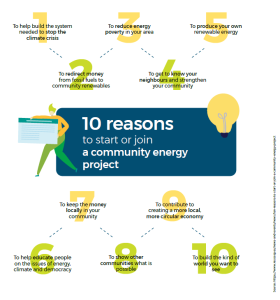5
Tanja Kamin; Urša Golob; Primož Medved; and Tina Kogovšek
There are many forms of community energy: from community projects to non-profit organisations, from smaller communities to bigger established cooperatives, from neighbours buying solar PV together, to larger, even international communities, with thousands of members. Just like communities differ in shapes and sizes, so too differ the motivations to join them. Some researchers have concluded that what motivates energy community members most are financial benefits, while other research, including one investigation carried out by the NEWCOMERS project, suggests that environmental motives can play an equally significant role.
Regardless of what the most common motivating factors are, it is important to understand and acknowledge that people join communities for different reasons. Understanding the variety of possible motives can play a pivotal role in energy community promotion and recruitment of new members.
We can divide the motives for joining energy communities into five categories:
- Financial motives (including electricity cost reduction or investment opportunities)
- Environmental motives (lowering one’s environmental footprint)
- Social motives (being part of a community, a movement addressing climate change)
- Technological motives (engaging with new technologies)
- Energy independence/security motives (independence from large power companies, contributing to energy security)
Many people decide whether to join an energy community based on these motives. Given the novelty of the energy community phenomenon, joining or establishing a community can involve a certain level of risk. An important factor in mitigating perceived risk for potential members is the concept of trust.
For a successful and long-lasting energy community, the members should trust in the competence and knowledge of the community leaders as well as other community members.
Trust plays a particularly important role in those communities that require active participation from their members. Thus, the community needs to build and grow relationships and keep the community members connected. Energy communities can improve their members’ engagement through a range of activities, such as defining roles for members, community events, establishing community communication channels or developing side projects that stimulate community life (such as educational programmes for schools, community gardens, repair cafés, etc.).
Want to learn more?

